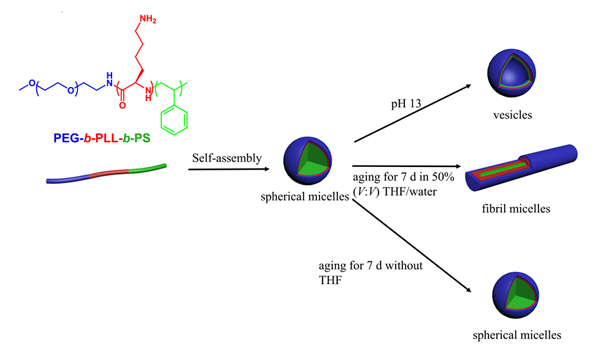[1] Mai, Y.; Eisenberg, A. Chem. Soc. Rev. 2012, 41, 5969.
[2] Qiu, H.; Gao, Y.; Boott, C. E.; Gould, O. E. C.; Harniman, R. L.; Miles, M. J.; Webb, S. E. D.; Winnik, M. A.; Manners, I. Science 2016, 352, 697.
[3] Qiu, H.; Hudson, Z. M.; Winnik, M. A.; Manners, I. Science 2015, 347, 1329.
[4] Gröschel, A. H.; Walther, A.; Löbling, T. I.; Schacher, F. H.; Schmalz, H.; Müller, A. H. Nature 2013, 503, 247.
[5] Xu, X.; Wu, G.; Zhang, J.; Wang, Y.; Fan, Y.; Ma, J. Acta Chim. Sinica 2008, 66, 1102(in Chinese). (徐旭, 伍国琳, 张洁, 王亦农, 范云鸽, 马建标, 化学学报, 2008, 66, 1102.)
[6] Cademartiri, L.; Bishop, K. J. M. Nat. Mater. 2015, 14, 2.
[7] Walther, A.; Müller, A. H. Chem. Rev. 2013, 113, 5194.
[8] Movassaghian, S.; Merkel, O. M.; Torchilin, V. P. Wiley Interdiplinary Reviews Nanomedicine & Nanobiotechnology 2015, 7, 691.
[9] Jiang, J.; Shen, N.; Ci, T.; Tang, Z.; Gu, Z.; Li, G.; Chen, X. Adv. Mater. 2019, 31, 1.
[10] Li, Z.; Kesselman, E.; Talmon, Y.; Hillmyer, M. A.; Lodge, T. P. Science 2004, 306, 98.
[11] Kubowicz, S.; Baussard, J. F.; Lutz, J. F.; Thünemann, A. F.; Berlepsch, H. V.; Laschewsky, A. Angew. Chem. Int. Ed. 2005, 44, 5262.
[12] Gröschel, A. H.; Schacher, F. H.; Schmalz, H.; Borisov, O. V.; Zhulina, E. B.; Walther, A.; Müller, A. H. Nat. Commun. 2012, 3, 710.
[13] Zhuang, Z.; Jiang, T.; Lin, J.; Gao, L.; Yang, C.; Wang, L.; Cai, C. Angew. Chem. Int. Ed. 2016, 55, 12522.
[14] Zhang, L.; Eisenberg, A. Science 1995, 268, 1728.
[15] Hadjichristidis, N.; Hirao, A.; Tezuka, Y.; Prez, F. D. Wiley InterScience, John Wiley & Sons Inc., New York, 2011, p. 823.
[16] Zhang, J.; Chen, X.; Wei, H.; Wan, X. Chem. Soc. Rev. 2013, 42, 9127.
[17] Chen, P.; Qiu, M.; Deng, C.; Meng, F.; Zhang, J.; Cheng, R.; Zhong, Z. Biomacromolecules 2015, 16, 1322.
[18] Ran, M.; Shi, D.; Dong, H.; Chen, M.; Zhao, Z. Acta Chim. Sinica 2015, 73, 1047(in Chinese). (冉茂双, 施冬健, 董罕星, 陈明清, 赵增亮, 化学学报, 2015, 73, 1047.)
[19] Sheng, L.; Chen, H.; Fu, W.; Li, Z. Acta Polym. Sinica 2015, 8, 982(in Chinese). (盛力, 陈红, 符文鑫, 李志波, 高分子学报, 2015, 8, 982.)
[20] Sheng, L.; Chen, H.; Fu, W.; Li, Z. Langmuir 2015, 31, 11964.
[21] Boott, C. E.; Gwyther, J.; Harniman, R. L.; Hayward, D. W.; Manners, I. Nat. Chem. 2017, 9, 785.
[22] Yu, K.; Eisenberg, A. Macromolecules 1996, 29, 6359.
[23] Betthausen, E.; Hanske, C.; Müller, M.; Fery, A.; Schacher, F. H.; Müller, A. H. E.; Pochan, D. J. Macromolecules 2014, 47, 1672.
[24] Zhang, S.; Li, Q.; Lin, J.; Cai, C.; Wang, L. Acta Polym. Sinica 2017, 2, 294(in Chinese). (张朔, 李庆, 林嘉平, 蔡春华, 王立权, 高分子学报, 2017, 2, 294.)
[25] Bhargava, P.; Tu, Y.; Zheng, J.; Xiong, H.; Quirk, R. P.; Cheng, S. Z. D. J. Am. Chem. Soc. 2007, 129, 1113.
[26] Özdemir, C.; Güner, A. Eur. Polym. J. 2007, 43, 3068.
[27] Rozenberg, M.; Shoham, G. Biophys. Chem. 2007, 125, 166.
[28] Prestrelski, S. J.; Tedeschi, N.; Arakawa, T.; Carpenter, J. F. Biophys. J. 1993, 65, 661.
[29] Mauerer, A.; Lee, G. Eur. J. Pharm. Sci. 2006, 62, 131.
[30] Jain, S.; Bates, F. S. Macromolecules 2004, 37, 1511.
[31] Rager, T.; Meyer, W. H.; Wegner, G. Macromol. Chem. Phys. 1999, 200, 1672.
[32] Stam, J. V.; Creutz, S.; Schryver, F. C. D.; Jérôme, R. Macromolecules 2000, 33, 6388.
[33] Zhang, L.; Barlow, R. J.; Eisenberg, A. Macromolecules 1995, 28, 6055.
[34] Tuzar, Z.; Kratochvil, P. Surf. Colloid Sci. 1993, 15, 1.
[35] Munk, P. Solvents and Self-Organization of Polymers, Springer, Netherlands, New York, 1996, p. 19.
[36] Zhang, Y.; Jiang, M.; Zhao, J.; Wang, Z.; Dou, H.; Chen, D. Langmuir 2005, 21, 1531.
[37] Lei, L.; Gohy, J.; Willet, N.; Zhang, J.; Varshney, S.; Jérôme, R. Macromolecules 2004, 37, 1089.
[38] Jada, A.; Hurtrez, G.; Siffert, B.; Riess, G. Macromol. Chem. Phys 1996, 197, 3697.
[39] Zhang, L.; Yu, K.; Eisenberg, A. Science 1996, 272, 1777.
[40] Ray, J. G.; Naik, S. S.; Hoff, E. A.; Johnson, A. J.; Ly, J. T.; Easterling, C. P.; Patton, D. L.; Savin, D. A. Macromol. Chem. Phys. 2012, 33, 819.
[41] Naik, S. S.; Ray, J. G.; Savin, D. A. Langmuir 2011, 27, 7231.
[42] Zhang, W.; He, J.; Liu, Z.; Ni, P.; Zhu, X. J. Polym. Sci. Part A:Polym. Chem. 2010, 48, 1079.
[43] Jackson, M.; Mantsch, H. H. Crit. Rev. Biochem. Mol. 1995, 30, 95.
[44] Dzwolak, W.; Smirnovas, V. Biophys. Chem. 2005, 115, 49.
[45] Mirtič, A.; Grdadolnik, J. Biophys. Chem. 2013, 175-176, 47. |
